Charles Dickens


Charles Dickens
(1812-1870)
novelist, journalist, and policeman (1860)
Family tree
friend of Thomas Latimer
Commemorated on 71 plaques
Charles Dickens 1812-1870 novelist lived here
48 Doughty Street, Camden, WC1, London, United Kingdom where they lived
Charles Dickens visited John Leech 1817-1864 humorous artist who lived here in 1849
16 Lansdowne Place, Hove, United Kingdom where they visited (1849)
This building housed the offices of Charles Dickens' magazine 'All The Year Round' and his private apartments 1859-1870
Wellington Street WC2, London, United Kingdom where they lived and published the 'All The Year Round' magazine
Charles Dickens 1812-1870 writer, journalist and social reformer
Charles Dickens Primary School, Lant Street, Borough, London, United Kingdom where they was
Charles Dickens 1812-1870 made several visits to this ancient house in the 1830's
Pilgrims, 4–6 Borough Lane, Eastbourne, United Kingdom where they visited
Here lived Charles Kitterbell as related by Charles Dickens in Sketches by Boz "The Bloomsbury Christening"
14 Great Russell Street, WC1, London, United Kingdom where they wrote about
As a boy Charles Dickens worked here 1824 - 1825
6 Chandos Place, London, United Kingdom where they worked (1823-1824)
Music Hall, Nelson Street. Charles Dickens 1812 - 1870. Charles Dickens gave public readings of his works in this theatre during 6 visits to Newcastle between 1852 and 1867. "A finer audience there is not in England"
Nelson Street, Newcastle upon Tyne, United Kingdom where they performed (1852-1867)
While living in a house on this site Charles Dickens wrote six of his principal works. Characters from which appear in this sculptured panel
Marylebone High Street, London, United Kingdom where they lived and wrote six of his principal works
Charles Dickens 1812-1870 Author Stayed here in 1832
92 North Road, N6, London, United Kingdom where they stayed (1831)
Charles Dickens was born in this house on 7th February 1812
393 Old Commercial Road, Portsmouth, United Kingdom where they was born (1812)
1851-60 Charles Dickens novelist lived in Tavistock House near this site
Tavistock House South, Tavistock Square, WC1, London, United Kingdom where they lived (1851-1860)
In this house Charles Dickens lived 1817-1821
2 Ordnance Terrace, Chatham, United Kingdom where they lived (1816-1820)
Near this house in Hawke Street in 1812 lived Charles Dickens novelist 1812-1870
Hawke Street, Portsmouth, United Kingdom where they lived near
In this building in 1859 and 1860 the novelist Charles Dickens (1812-1870) gave selected readings from his many works
New Theatre, Kingston Square, Hull, United Kingdom where they gave selected readings from his many works (1859-1860)
Prolific journalist, novelist and, for one day in 1860 Liverpool police constable Charles Dickens born Portsea 1812 died Gad's Hill, Kent 1870 Liverpool lies in my heart second only to London so wrote Dickens, whose first visit was in 1838. From 1842 until 1869, he was a frequent visitor, giving readings from his novels, usually to large audiences at St George's Hall, also at the former Masque Theatre, Duke Street. In 1860 he was sworn in as a constable for 'research purposes'
1 Campbell Square, Liverpool, United Kingdom where they sworn in as a constable (1860)
1835-1837 Liverpool Mechanics' Institution Designed by A. H. Holme Charles Dickens gave readings here
Mount Street, Liverpool, United Kingdom where they gave readings (1834-1836)
Eastgate House Built by the Right Worshipful Sir Peter Buck 1590-1. "Westgate House" "Pickwick Papers". "The Nun's House" "Edwin Drood".
High Street, Rochester, United Kingdom where they wrote about
Theatre Royal. A theatre stood on the site of this building from circa 1700-1884. Charles Dickens visited it as a boy and later wrote about it in "The Uncommercial Traveller" and "The Mystery of Edwin Drood".
Star Hill, Rochester, United Kingdom where they visited
Watts' Charity Charles Dickens visited Watts' Charity on May 11th, 1854, and subsequently wrote "The Seven Poor Travellers".
High Street, Rochester, United Kingdom where they visited (1854)
Mr. Tope's This was the home of Mr. Tope, the chief verger of the cathedral in "The Mystery of Edwin Drood". It is the last building mentioned in the writings of Charles Dickens.
High Street, Rochester, United Kingdom where they mentioned in The Mystery of Edwin Drood
The Bull Hotel This "good house" with "nice beds" described by Mr. Jingle in "Pickwick Papers", is also "The Blue Boar" in "Great Expectations".
High Street, Rochester, United Kingdom where they wrote about
Charles Dickens 1812-1870 author of The Pickwick Papers stayed here
The Angel Hotel, 3 Angel Hill, Bury St Edmunds, United Kingdom where they stayed
Charles Dickens 1812-1870 was a frequent visitor to the Bedford Hotel which stood on this site until 1964
Holiday Inn Hotel (former Bedford Hotel), 137 Kings Road, Brighton, United Kingdom where they stayed
While staying in this house Charles Dickens (English novelist) wrote part of "David Copperfield" in 1849. Myles Birket Foster (watercolour artist) painted "On The Shore, Bonchurch" in 1862. William Adams (Christian scholar, author of "The Sacred Allegories") lived here from 1843 until his death in 1848
Shore Road, Bonchurch, Ventnor, Isle of Wight, United Kingdom where they stayed and wrote part of David Copperfield (1849)
Charles Dickens stayed here in 1857 and 1862 "They gave you bride cake every day after dinner"
75 Market Street, Lancaster, United Kingdom where they stayed (1857-1852)
In the Theatre Royal on this site Charles Dickens gave a public reading of "David Copperfield" on 4th November 1861
Guildhall Street, Canterbury, United Kingdom where they gave a public reading of "David Copperfield" (1861)
Beyond this old wall is the site of Marshalsea Prison, closed in 1842. This sign is attached to a remnant of the prison wall. Charles Dickens, whose father had been imprisoned here for debt in 1824, used that experience as the Marshalsea setting for his novel Little Dorrit.
Tabard Street Gardens, SE1, London, United Kingdom where they used the experience of his father having been imprisoned here for debt in 1824 as the Marshalsea setting for his novel Little Dorrit
St. George's Hall. Designed by Lockwood and Mawson and built in 1853 for public meetings, concerts and lectures. Palmerston and Dickens spoke here.
Hall Ings, Bradford, United Kingdom where they spoke
The George Inn. It is known that the George Inn existed in the late 16th Century although the present building dates from 1677. Both Shakespeare and Dickens knew the hospitality of the inn which has continued right up to the present day. The inn is now owned by The National Trust
73 Borough High Street, Southwark, SE1, London, United Kingdom where they stayed
Site of "White Hart Inn" immortalized by Shakespeare in "Henry VI" & Dickens in "Pickwick Papers"
White Hart Yard, Borough High Street, Southwark, SE1, London, United Kingdom where they wrote about
In the courtyard at the rear of this building is the George-London's only galleried inn. Immortalized by Charles Dickens in "Little Dorrit"
73 Borough High Street, London, United Kingdom where they was
Here while searching for his aunt Betsey Trotwood David Copperfield rested on the doorstep and ate the loaf he had just bought. Charles Dickens 1850
7 Market Square, Dover, United Kingdom where they wrote about
Charles Dickens stayed here on February 1st & 2nd, 1838, while collecting material for his novel "Nicholas Nickleby".
14 Market Place, Barnard Castle, United Kingdom where they stayed (2013)
The site of one of two premises used by Thomas Humphreys, clock-maker, made famous by Charles Dickens in "Master Humphrey's Clock".
1 Newgate, Barnard Castle, United Kingdom where they wrote about
The site of one of two premises used by Thomas Humphreys, clock-maker, made famous by Charles Dickens in "Master Humphrey's Clock".
9 Market Place, Barnard Castle, United Kingdom where they wrote
Charles Dickens lived here, 1839, 1840, 1845, 1849 & 1859, and wrote part of Nicholas Nickleby.
12 Albion Street, Broadstairs, United Kingdom where they lived (1838), lived (1839), lived (1844), lived (1849), lived (1859), and wrote part of Nicholas Nickleby
In this house lived the original of Betsey Trotwood in "David Copperfield" by Charles Dickens, 1849
Dickens House Museum, 2 Victoria Parade, Broadstairs, United Kingdom where they was
Charles Dickens 1812-1870 novelist stayed here, the home and printworks of Thomas Latimer 1803-1888 campaigning journalist
143 Fore Street, Exeter, United Kingdom where they stayed
143 Fore Street 18th Century Merchants House Built in 1714 by Sir Thomas Bury, merchant: sold to Sir John Duntze (also a merchant) in 1733 and lived in by his family until 1788. In the 19th century it became the offices of the 'Western Times' which was printed in the adjacent buildings. Charles Dickens, who was a personal friend of Thomas Latimer, the paper's proprietor and editor, stayed here in 1839.
143 Fore Street, Exeter, United Kingdom where they stayed (1838)
Assembly Rooms. Built in 1857, Charles Dickens gave readings here 1858.
4-6 Huntriss Row, Scarborough, United Kingdom where they gave readings (1858)
St. Nicholas's Chapel. Originally a medieval chapel, this was Chester's Commonhall in the 16th Century and later became the Wool Hall. It was licensed as the Theatre Royal in 1777, and converted into the Chester Music Hall by James Harrison in 1855. Charles Dickens performed here in 1867.
St Nicholas Chapel, St Werburgh Street, Chester, United Kingdom where they performed (1867)
Charles Dickens 1812-1870 stayed here at the George Hotel and in "Nicholas Nicklesby" described it as 'one of the best inns in England'
George Hotel, Grantham, United Kingdom where they stayed
Charles Dickens lived in a house on this site when a boy in 1823
141 Bayham Street, Camden, London, United Kingdom where they lived (1822)
Charles Dickens novelist lived here B: 1812. D: 1870
Prudential Buildings, 138–142 Holborn, EC1, London, United Kingdom where they lived
Charles Dickens 1812-1870 spent his last night in Portsmouth here on 25th May 1866 in the Pier Hotel
Southsea Terrace, Portsmouth, United Kingdom where they stayed
On this site stood The Bush, a celebrated coaching inn. Edmund Burke M.P. used it as his election campaign headquarters. In Pickwick Papers, Charles Dickens had Mr. Winkle stay there. The inn later became Bush Chambers, where Bristol & West Building Society was founded in 1850. The present building was erected in 1857 by The West of England and South Wales District Bank. The Architects W. B. Gingell and T. R. Lysaght based its High Renaissance style on Jacopo Sansovino's Library of St. Mark, Venice. It has been occupied by Lloyds Bank Limited since 1892 and the exterior remains substantially in its original form.
Corn Street, Bristol, United Kingdom where they wrote about
Where the civic centre now stands was the Swinton Moral and Industrial School set up by the Manchester Poor Law Union. 'Union' was the name given to groups of parishes which had joined together to provide workhouses. The Manchester Union was one of the first to set up a large separate institution for pauper children. Charles Dickens himself visited the school in 1850 and said that it could easily be mistaken for a duke's country seat. He called it a pauper's palace. Swinton Industrial School Opened in 1846 - Closed 1925 'The Pauper's Palace' also locally known as "The Bastille"
Chorley Road, Swinton, United Kingdom where they was
Built c 1780. Top o' th' Brow. The rear part of this building was home to William and Grace Grant after their arrival in Ramsbottom in 1806. Sons William and Daniel Grant owned the nearby Old Ground calico printworks. They are believed to be the inspiration for Charles Dickens' Cheeryble brothers in his 1838-39 novel Nicholas Nickleby. The present frontage was added and the house became The Grant Arms Hotel 1828.
11 Market Place, Ramsbottom, BL9 0LD, Ramsbottom, United Kingdom where they wrote about
In the Music Hall which stood on this site, Charles Dickens read from A Christmas Carol and Pickwick Papers, 6th November 1861
53 Robertson Street, Hastings, United Kingdom where they performed (1861)
Hanbury Hall Built 1719 as a French Huguenot Church. Used by La Patente Church 1740 onwards. John Wesley preached here. 1787 it became a German Lutheran Church. Used by the Baptists then the United Free Methodists. Charles Dickens gave public readings here. 1887 Christ Church bought the building as its Church Hall. 1888 Annie Besant and Eleanor Marx-Aveling held the matchstick girls strike meetings here which helped to establish the British Trade Unions. Throughout its life this hall has served Church, community and nation.
22 Hanbury Street Spitalfields, London, United Kingdom where they performed
The Lion. Dating from before 1618, the premier coaching on the London-Holyhead route. Famous visitors include Charles Dickens, Paganini, William IV, Jenny Lind, D'Quincy, Madame Tussaud, Disraeli. Particular features of note include Adam Ballroom & Tapestry Lounge
Wyle Cop, Shrewsbury, United Kingdom where they visited
Charles Dickens's Wine Cellar The wine cellar used by Charles Dickens during his time at Doughty Street has been restored and refitted with the financial assistance of national wine merchants Peter Dominic.
Charles Dickens Museum, 48 Doughty Street, London, United Kingdom where they was
Kentucky Historical Marker #1681
Louisville's Steamboat Era. River navigation in 18th century was by flatboat and keelboat. First steamboat, NEW ORLEANS, arrived in Louisville in autumn of 1811. City soon became steamboat center with six lines operating here. Hundreds of these boats were built in area. Wharf teemed with traffic through Civil War. Eight U.S. presidents arrived on this wharf or "levee." (Reverse) Visitors at Louisville Wharf James Monroe - June 1819 Andrew Jackson - June 1819 Alexis de Tocqueville - Dec. 1831 Washington Irving - Sept. 1832 Abraham Lincoln - Sept. 1841 Charles Dickens - Apr. 1842 Walt Whitman - Feb. 1848 Ralph Waldo Emerson - June 1850 Oliver W. Holmes - Sept. 1855 Herman Melville - Jan.1858
At the Wharf, 4th St., Louisville, KY, United States where they visited (1840)
Charles Dickens novelist born 1812 died 1870 lived for a time in Furnivals Inn close to this spot and there wrote Pickwick in the year 1836.
, London, United Kingdom where they lived
Sun Hotel formerly known as The Little Inn made famous by Chas. Dickens in his travels thro' Kent Built 1503
, Canterbury, United Kingdom where they wrote about
Young Charles Dickens twice lived in this house 1815-16 and 1828-31 a few doors from the Cleveland Street Workhouse Dickens's first London home
22 Cleveland Street, London, United Kingdom where they was
St George's Hall. Bradford's first public building was designed by celebrated architects Henry Francis Lockwood and William Mawson, and financed by public subscription. It has hosted, amongst others, Charles Dickens, Winston Churchill and Harry Houdini, and is one of the oldest concert halls still in use in Europe. Erected 1853
St George's Hall, Bradford, United Kingdom where they performed
Site of the Rose & Crown Inn reputedly The Town Arms of Eatan Swill of Charles Dickens
Winch & Blatch - 40 King Street, Sudbury, United Kingdom where they inspired
The Bulls Head and Pump Corner. Supplying London coaches from the 18th century, the inn became famed in the 19th century for its coachman, William Broad, possibly the model for Charles Dickens' Toby Weller in The Pickwick Papers. At the opposite corner stands the pump. It was installed in 1780 to draw water from the well which had been the centre of the town since the Middle Ages.
South Street, Dorking, United Kingdom where they wrote about
Charles Dickens lived in a house on this site 1824-1829 Later to be the home of The David Copperfield Childrens Library 1922-1932
9-16 Cranleigh Houses, Cranleigh Street, Somers Town, London, United Kingdom where they was
Charles Dickens 1812 - 1870 novelist lived here in boyhood
Garden of the Charles Dickens Museum, 48 Doughty Street, London, United Kingdom where they was
These steps and arch are surviving fragments of the 1831 London Bridge designed by John Rennie and built by his son Sir John Rennie. These steps were the scene of the murder of Nancy in Charles Dickens' novel Oliver Twist.
Montague Close, London, United Kingdom where they wrote about
Charles Dickens lived here in 1855 writing part Little Dorrit in this house
Albion Villas, Folkestone, United Kingdom where they lived (1855)
In 1852 Charles Dickens and his family lodged nearby in Camden Crescent while he wrote parts of Bleak House. The author Wilkie Collins was a regular visitor.
17 Camden Crescent, Dover, United Kingdom where they was
Charles Dickens (1812-1870) author and social critic visited here in 1858
Script Haven bookshop, Worcester, United Kingdom where they stayed
1812-1870 Charles Dickens allegedly stabled his horse here
6 Oscar Road, Broadstairs, United Kingdom where they was
Charles Dickens Stayed at this hotel on 26th Sept. 1858 and 25th Nov. 1861. On the latter date he gave a reading in the adjoining assembly rooms.
King's Arms Hotel, Hide Hill, Berwick-upon-Tweed, United Kingdom where they stayed
'A Christmas Carol' by Charles Dickens The first public reading of this story was made by Charles Dickens in Birmingham Town Hall on Tuesday 27th December 1853 to an audience of nearly 2,000 people.
Birmingham Town Hall, Victoria Square, Birmingham, United Kingdom where they performed (1853)



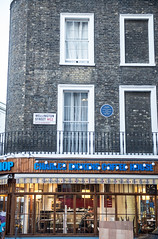
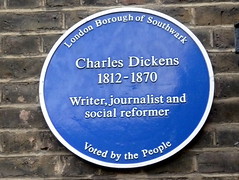
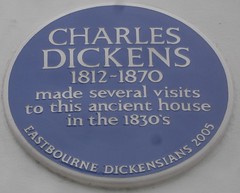
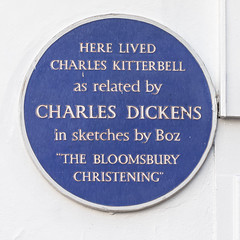
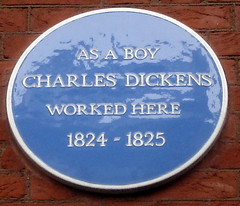



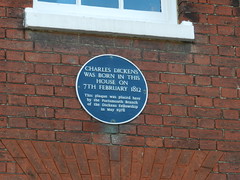


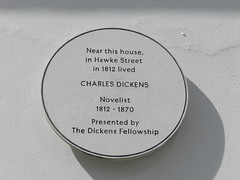
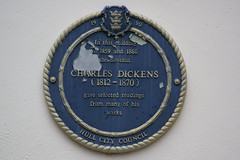
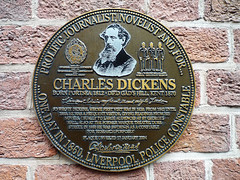
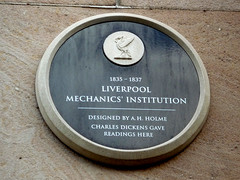
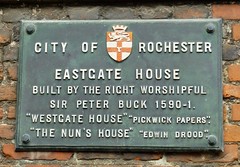

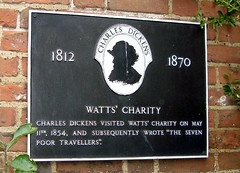
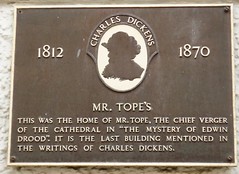


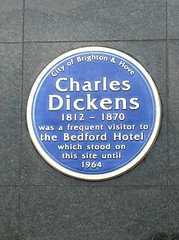
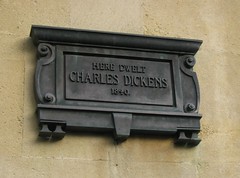

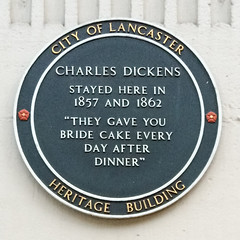
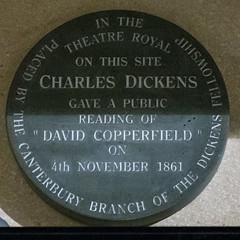

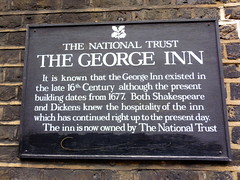
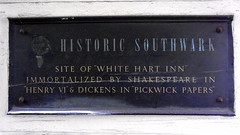

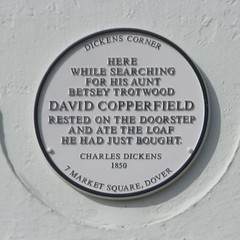



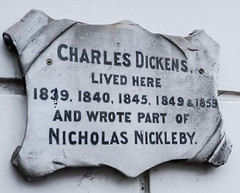






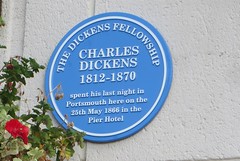
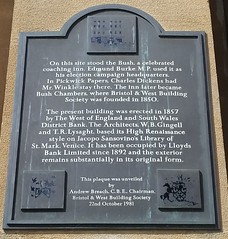
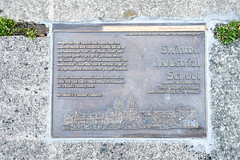
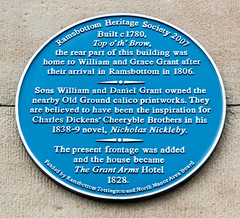
.jpg?width=250)
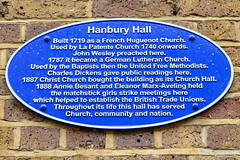
.jpg?width=250)

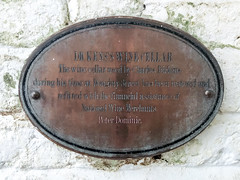


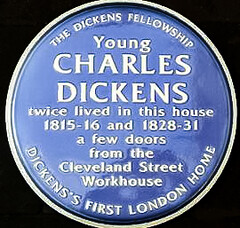
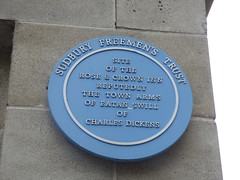
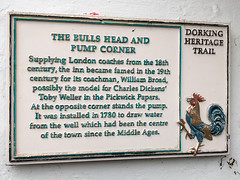
.jpg?width=250)



